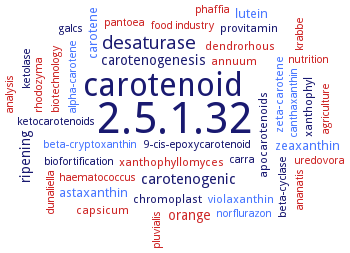2.5.1.32: 15-cis-phytoene synthase
This is an abbreviated version!
For detailed information about 15-cis-phytoene synthase, go to the full flat file.

Word Map on EC 2.5.1.32 
-
2.5.1.32
-
carotenoid
-
desaturase
-
carotenogenic
-
ripening
-
carotenogenesis
-
orange
-
zeaxanthin
-
carotene
-
astaxanthin
-
lutein
-
capsicum
-
xanthophyl
-
annuum
-
xanthophyllomyces
-
provitamin
-
apocarotenoids
-
dendrorhous
-
violaxanthin
-
zeta-carotene
-
chromoplast
-
nutrition
-
alpha-carotene
-
ananatis
-
pantoea
-
krabbe
-
canthaxanthin
-
analysis
-
phaffia
-
dunaliella
-
9-cis-epoxycarotenoid
-
ketolase
-
uredovora
-
pluvialis
-
food industry
-
ketocarotenoids
-
norflurazon
-
beta-cryptoxanthin
-
beta-cyclase
-
carra
-
haematococcus
-
biofortification
-
biotechnology
-
agriculture
-
galcs
-
rhodozyma
- 2.5.1.32
-
carotenoid
-
desaturase
-
carotenogenic
-
ripening
-
carotenogenesis
- orange
- zeaxanthin
- carotene
- astaxanthin
- lutein
- capsicum
-
xanthophyl
- annuum
- xanthophyllomyces
-
provitamin
-
apocarotenoids
- dendrorhous
- violaxanthin
- zeta-carotene
- chromoplast
- nutrition
- alpha-carotene
- ananatis
- pantoea
- krabbe
- canthaxanthin
- analysis
- phaffia
- dunaliella
-
9-cis-epoxycarotenoid
-
ketolase
- uredovora
- pluvialis
- food industry
-
ketocarotenoids
- norflurazon
- beta-cryptoxanthin
-
beta-cyclase
-
carra
- haematococcus
-
biofortification
- biotechnology
- agriculture
-
galcs
- rhodozyma
Reaction
2 geranylgeranyl diphosphate
=
Synonyms
AtPSY, CitPsy, CrtB, crtYB, EgcrtB, fruit-specific phytoene synthase, geranylgeranyl-diphosphate geranylgeranyltransferase, MaPsy1, MaPsy2, phytoene synthase, phytoene synthase 1, phytoene synthase 2, phytoene synthase/lycopene cyclase, phytoene synthetase, phytoene-synthetase, prephytoene-diphosphate synthase, Psase, PSY, PSY protein, PSY1, PSY1a, PSY1b, PSY1C, PSY2, PSY3, PSY5, synthetase, phytoene, sZmPSY1, TaPSY1, TaPSY2, TaPSY3, YELLOW-FRUITED TOMATO 2, yft2, Zmpsy1
ECTree
Advanced search results
Cloned
Cloned on EC 2.5.1.32 - 15-cis-phytoene synthase
Please wait a moment until all data is loaded. This message will disappear when all data is loaded.
after transformation psy is not only expressed in leaves but also in roots and seed derived calli, leading to coloured roots
after transformation with bacterial crtB PSY transcrips are detectable and the white roots get coloured
after transformation with bacterial crtB PSY was not only expressed in leaves but also in roots, leading to coloured roots (roots of wild carrots are white)
-
Agrobacterium-mediated transformation of hypocotyl explants of Brassica napus, 50fold increase in carotenoid levels
-
astaxanthin yield in Saccharomyces cerevisiae is enhanced by combinational metabolic engineering and protein engineering targeting at the insufficient precursor supply and the weak downstream pathway capacity. Through introducing the positive GGPP synthase mutant CrtE03M together with overexpression of tHMG1, CrtI and CrtYB (from the cDNA of Xanthophyllomyces dendrorhous), the supply of the precursor beta-carotene is increased. Efficient conversion of beta-carotene to astaxanthin is achieved through increasing beta-carotene ketolase activity via directed evolution
cloning and genetic analysis of fruit-specific phytoene synthase, PSY1, and mutant lines tangerine and yellow-flesh with mutant alleles t3183 and r2997, respectively
-
expressed in peanut Arachis hypogaea under control of the Arabidopsis thaliana oleosin promoter after transformation with Agrobacterium tumefaciens
-
expressed under the control of the cauliflower mosaic virus 35S constitutive promoter or the Arabidopsis thaliana fatty acid elongase 1 gene seed-specific promoter in linseed flax Linum usitatissimum after transformation with Agrobacterium tumefaciens, in both cases transcripts are only detectable in seeds but not in leaves
-
expression in Escherichia coli
expression in Escherichia coli. Two genes for the two reaction steps: 1. formation of phytoene diphosphate from geranylgeranyl diphosphate and 2. formation of phytoene from prephytoene diphosphate
-
full length and truncated cDNA expression constructs of the phytoene synthase gene from tomato ligated into a pUC8 cloning vector, expression in Escherichia coli carrying Erwinia uredovora geranylgeranyl diphosphate synthase gene
-
gene crtB, DNA and amino acid sequence determination and analysis, functional expression of the His-tagged enzyme lacking the chloroplast transit peptide in Escherichia coli strain BL21(DE3) mostly in inclusion bodies
Citrus sp.
-
gene crtB, DNA and amino acid sequence determination and analysis, sequence comparison and phylogenetic analysis, quantitative real-time PCR enzyme expression analysis
overexpressed in insect Sf9 cells using the baculovirus lipofection system. The full-length overexpressed enzyme exhibits very reduced catalytic activity compared with an overexpressed N-truncated form, with its transit sequence of 214 base pairs removed from the psy cDNA at the 5'-end by site-directed mutagenesis. The shortened form readily binds to lipid bilayers
-
overexpressed to about 20% of the total cellular protein in Escherichia coli. Formation of the active phytoene synthase has the effect of suppressing the growth of the expressing strain. Inhibition of growth arises from the depletion of the substrate geranylgeranyl diphosphate which, in Escherichia coli, is necesssary for the synthesis of essential propyldiphosphate derivatives. In order to overcome the poor growth characteristics of the phytoene expressing strain, the enzyme level is increased by co-expressing the isoprenoid biosynthetic genes crtE and idi, encoding Erwinia geranylgeranyl diphosphate synthase and Rhodobacter isopentenyl diphosphate isomerase, respectively
-
overexpression in Lycopersicon esculentum, fruit-specific expression is achieved by using the tomato polygalacturonase promoter, and the enzyme is targeted to the chromoplast by the tomato phytoene synthase-1 transit sequence, total fruit carotenoids of primary transformants are 2-4fold higher than the control
-
overexpression in Saccharomyces cerevisiae. Yeast cells expressing CrtI, CrtYB, and CrtS from Xanthophyllomyces dendrorhous accumulate beta-carotene but not astaxanthin
Psy gene, DNA and amino acid sequence determination and analysis, phylogenetic analysis
the Japonica rice model variety Taipei 309 is transformed by microprojectile bombardment with a cDNA coding for phytoene synthase under the control of either a constitutive or an endosperm-specific promoter. In transgenic rice plants the enzyme is active
-
transgenic rice endosperm expressing phytoene synthase, phytoene desaturase and beta-carotene ketolase accumulates large amounts of canthaxanthin and adonirubin, plus additional ketocarotenoids in smaller amounts, such as astaxanthin


 results (
results ( results (
results ( top
top





